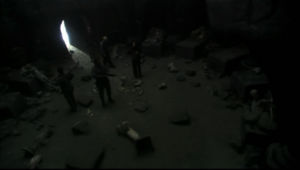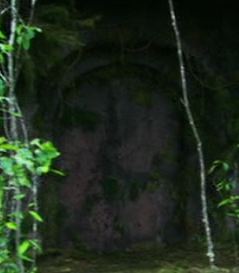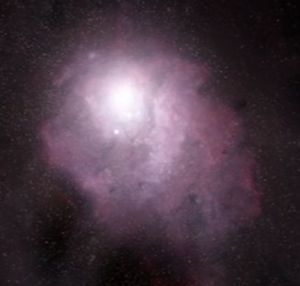Tomb of Athena: Difference between revisions
Spencerian (talk | contribs) No edit summary |
(→Notes: It's not similar. It's identical. The Lagoon nebula is M8 in the Messier catalogue) |
||
| Line 24: | Line 24: | ||
[[Image:lagoonnebula.jpg|thumb|right|The Lagoon Nebula in the constellation Scorpius.]] | [[Image:lagoonnebula.jpg|thumb|right|The Lagoon Nebula in the constellation Scorpius.]] | ||
*Adama notes that the Lagoon Nebula is known to the Colonials as "astro-body M8". This | *Adama notes that the Lagoon Nebula is known to the Colonials as "astro-body M8". This notation is the same one used for the nebula in the Messier catalogue, devised in 1774 by astronomer [[w:Charles Messier|Charles Messier]]. The nebula, in reality, appears as a gray object in the sky with binoculars or telescope. It would not be as vivid or large in the sky by the naked eye as it was shown in the group's vision. The object is 5,200 light years from Earth, lies in the constellation of [[w:Sagittarius (constellation)|Sagittarius]], not Scorpius, a [[Continuity errors (RDM)#Acknowledged Mistakes|mistake]] which has been admitted by the writers. | ||
* The producers have acknowledged<ref>{{cite_rdm_podcast|episode=Home, Part II|act=4|id=zodiac1|timestamp=|totalrunning=}}</ref> that the twelve constellations of the Zodiac are never actually all visible at once in the night sky, but rather rotate around the north star throughout the night. The constellations were displayed as in the hologram for dramatic and informative purposes. | * The producers have acknowledged<ref>{{cite_rdm_podcast|episode=Home, Part II|act=4|id=zodiac1|timestamp=|totalrunning=}}</ref> that the twelve constellations of the Zodiac are never actually all visible at once in the night sky, but rather rotate around the north star throughout the night. The constellations were displayed as in the hologram for dramatic and informative purposes. | ||
Revision as of 14:28, 5 June 2007
- For other uses of this name in Battlestar Galactica, see Athena.

The Tomb of Athena is presumably the final resting place of Athena, Lord of Kobol after her grief-stricken plunge from the Gates of Hera. It is unclear who interred her, since her death apparently took place after the exodus of the thirteen tribes from Kobol.
The tomb is located in the northern hemisphere, a few days hike from the Galleon Meadow, near the Gates of Hera, to the west of the ruins of the City of the Gods (Home, Part II). According to the Sacred Scrolls, the tomb could only be opened with the Arrow of Apollo.

The Arrow is not a key to the tomb's actual door, however. While the exterior door to the tomb can be opened by brute force, the Arrow is required for something else. The tomb contains twelve stone sarcophagi arranged in a circle, each with ancient statues representing one of the Twelve Tribes which went on to found the Twelve Colonies. Picon was represented by a fish; Caprica, a goat; Sagittaron, an archer, and so on.

Kara Thrace places the Arrow in the bow of the Archer of Sagittaron. Immediately the Tomb's entrance closes, leaving those in the Tomb in darkness. After a few seconds, they find themselves in a grassy field at nighttime surrounded by twelve megalithic slabs,[1] either physically transported or immersed in a very sophisticated hologram.
On each column is the ancient symbol of a colony as used on their respective old Colonial flags. Roslin notes that the symbols were used back when the ancient names of the Colonies were used: Aries instead of Aerelon, Taurus for Tauron, Gemini for Gemenon, and so on.
Above the group, the night sky shows constellations, each representing a colony. In fact, Thrace realizes that, according to the Scriptures, that they were all standing on a representation of Earth, seeing what their comrades on Earth would see. The map information, however, was incomplete without one more stellar reference that Lee Adama finds in the Scorpius constellation: the Lagoon Nebula, an object visible on Earth and known as well to the Twelve Colonies. Lee Adama deduces that as they approached this point, the ship would be able to further define their position to Earth. Commander Adama notes that the nebula was "a long way away from here" (Home, Part II).
The group is not shown leaving the hologram or the Tomb. It can presumed that the group walked beyond the stones and the image faded to their actual location in the Tomb, then reopened the entrance - either by forcing it open once again or retrieving the Arrow - and exited.
Notes[edit]

- Adama notes that the Lagoon Nebula is known to the Colonials as "astro-body M8". This notation is the same one used for the nebula in the Messier catalogue, devised in 1774 by astronomer Charles Messier. The nebula, in reality, appears as a gray object in the sky with binoculars or telescope. It would not be as vivid or large in the sky by the naked eye as it was shown in the group's vision. The object is 5,200 light years from Earth, lies in the constellation of Sagittarius, not Scorpius, a mistake which has been admitted by the writers.
- The producers have acknowledged[2] that the twelve constellations of the Zodiac are never actually all visible at once in the night sky, but rather rotate around the north star throughout the night. The constellations were displayed as in the hologram for dramatic and informative purposes.
- While far longer a story arc, the events in finding and using the resources within the Tomb of Athena, a Lord of Kobol, is similar to the story line of an Original Series episode that also searches for the location of Earth from a tomb on a Kobol that was more reminiscent of Egyptian history than the quasi-Celtic, quasi-Greek appearances seen in the Re-imagined Series episode.
References[edit]
- ↑ The slabs were similar in appearance to those of the ancient Earth structure of Stonehenge.
- ↑ Podcast: Home, Part II , Act 4.